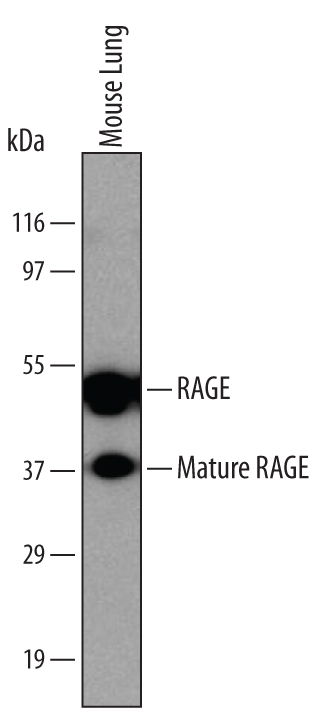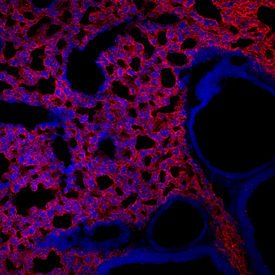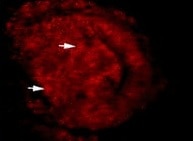Mouse/Rat RAGE Antibody Summary
Gly23-Ala342
Accession # NP_031451
Applications
Please Note: Optimal dilutions should be determined by each laboratory for each application. General Protocols are available in the Technical Information section on our website.
Scientific Data
 View Larger
View Larger
Detection of Mouse RAGE by Western Blot. Western blot shows lysates of mouse lung tissue. PVDF membrane was probed with 2 µg/mL of Rat Anti-Mouse/Rat RAGE Monoclonal Antibody (Catalog # 1179) followed by HRP-conjugated Anti-Rat IgG Secondary Antibody (Catalog # HAF005). Specific bands were detected for RAGE and mature RAGE at approximately 50 and 38 kDa, respectively (as indicated). This experiment was conducted under non-reducing conditions and using Immunoblot Buffer Group 1.
 View Larger
View Larger
RAGE in Mouse Lung. RAGE was detected in perfusion fixed frozen sections of adult mouse lung using Rat Anti-Mouse/Rat RAGE Monoclonal Antibody (Catalog # MAB1179) at 10 µg/mL overnight at 4 °C. Tissue was stained using the Northern-Lights™ 557-conjugated Anti-Rat IgG Secondary Antibody (red; Catalog # NL013) and counterstained with DAPI (blue). View our protocol for Fluorescent IHC Staining of Frozen Tissue Sections.
Reconstitution Calculator
Preparation and Storage
- 12 months from date of receipt, -20 to -70 °C as supplied.
- 1 month, 2 to 8 °C under sterile conditions after reconstitution.
- 6 months, -20 to -70 °C under sterile conditions after reconstitution.
Background: RAGE/AGER
Advanced glycation endproducts (AGE) are adducts formed by the non-enzymatic glycation or oxidation of macromolecules (1). AGE forms during aging and its formation is accelerated under pathophysiologic states such as diabetes, Alzheimer’s disease, renal failure and immune/inflammatory disorders. Receptor for Advanced Glycation Endoproducts (RAGE), named for its ability to bind AGE, is a multiligand receptor belonging the immunoglobulin (Ig) superfamily. Besides AGE, RAGE binds amyloid beta -peptide, S100/calgranulin family proteins, high mobility group B1 (HMGB1, also know as amphoterin) and leukocyte integrins (1, 2). The mouse RAGE gene encodes a 403 amino acid (aa) residue type I transmembrane glycoprotein with a 22 aa signal peptide, a 319 aa extracellular domain containing a Ig-like V‑type domain and two Ig-like Ce-type domains, a 21 aa transmembrane domain and a 41 aa cytoplasmic domain (3). The V‑type domain and the cytoplasmic domain are important for ligand binding and for intracellular signaling, respectively. Two alternative splice variants, lacking the V‑type domain or the cytoplasmic tail, are known (1, 4). RAGE is highly expressed in the embryonic central nervous system (5). In adult tissues, RAGE is expressed at low levels in multiple tissues including endothelial and smooth muscle cells, mononuclear phagocytes, pericytes, microglia, neurons, cardiac myocytes and hepatocytes (6). The expression of RAGE is upregulated upon ligand interaction. Depending on the cellular context and interacting ligand, RAGE activation can trigger differential signaling pathways that affect divergent pathways of gene expression (1, 7). RAGE activation modulates varied essential cellular responses (including inflammation, immunity, proliferation, cellular adhesion and migration) that contribute to cellular dysfunction associated with chronic diseases such as diabetes, cancer, amyloidoses, and immune or inflammatory disorders (1).
- Schmidt, A. et al. (2001) J. Clin. Invest. 108:949.
- Chavakis, T. et al. (2003) J. Exp. Med. 198:507.
- Renard, C. et al. (1997) Mol. Pharmacol. 52:54.
- Yonekura, H. et al. (2003) Biochem. J. 370:1097.
- Hori, O. et al. (1995) J. Biol. Chem. 270:25752.
- Brett, J. et al. (1993) Am. J. Pathol. 143:1699.
- Valencia, J.V. et al. (2004) Diabetes 53:743.
Product Datasheets
Citations for Mouse/Rat RAGE Antibody
R&D Systems personnel manually curate a database that contains references using R&D Systems products. The data collected includes not only links to publications in PubMed, but also provides information about sample types, species, and experimental conditions.
26
Citations: Showing 1 - 10
Filter your results:
Filter by:
-
Alveolar cell fate selection and lifelong maintenance of AT2 cells by FGF signaling
Authors: DG Brownfield, AD de Arce, E Ghelfi, A Gillich, TJ Desai, MA Krasnow
Nature Communications, 2022-11-21;13(1):7137.
Species: Mouse
Sample Types: Whole Tissue
Applications: IHC -
Comparison of the pathogenesis of SARS-CoV-2 infection in K18-hACE2 mice and Syrian golden hamster models
Authors: H Jeong, YW Lee, IH Park, H Noh, SH Kim, J Kim, D Jeon, HJ Jang, J Oh, D On, C Uhm, K Cho, H Oh, S Yoon, JS Seo, JJ Kim, SH Seok, YJ Lee, SM Hong, SH An, SY Kim, YB Kim, JY Hwang, HJ Lee, HB Kim, DG Jeong, D Song, M Song, MS Park, KS Choi, JW Park, JY Seo, JW Yun, JS Shin, HY Lee, KT Nam, JK Seong
Disease Models & Mechanisms, 2022-11-11;0(0):.
Species: Hamster, Mouse
Sample Types: Whole Tissue
Applications: IHC -
Essential role of IL-17 in acute exacerbation of pulmonary fibrosis induced by non-typeable Haemophilus influenzae
Authors: S Chen, X Zhang, C Yang, S Wang, H Shen
Theranostics, 2022-07-04;12(11):5125-5137.
Species: Mouse
Sample Types: Whole Tissue
Applications: IHC -
A conserved YAP/Notch/REST network controls the neuroendocrine cell fate in the lungs
Authors: YT Shue, AP Drainas, NY Li, SM Pearsall, D Morgan, N Sinnott-Ar, SQ Hipkins, GL Coles, JS Lim, AE Oro, KL Simpson, C Dive, J Sage
Nature Communications, 2022-05-16;13(1):2690.
Species: Mouse
Sample Types: Whole Tissue
Applications: IHC -
Heparan sulfate-dependent RAGE oligomerization is indispensable for pathophysiological functions of RAGE
Authors: M Li, CY Ong, CJ Langouët-A, L Tan, A Verma, Y Yang, X Zhang, DK Shah, EP Schmidt, D Xu
Elife, 2022-02-09;11(0):.
Species: Mouse
Sample Types: Cell Lysates
Applications: Western Blot -
DCN released from ferroptotic cells ignites AGER-dependent immune responses
Authors: J Liu, S Zhu, L Zeng, J Li, DJ Klionsky, G Kroemer, J Jiang, D Tang, R Kang
Autophagy, 2021-12-29;0(0):1-14.
Species: Mouse
Sample Types: Cell Lysates, In Vivo
Applications: Immunoprecipitation, Neutralization, Western Blot -
Differentiation of mouse fetal lung alveolar progenitors in serum-free organotypic cultures
Authors: K Gkatzis, P Panza, S Peruzzo, DY Stainier
Elife, 2021-09-29;10(0):.
Species: Mouse
Sample Types: Organoids
Applications: IHC -
Overexpression of the receptor for advanced glycation end-products in the auditory cortex of rats with noise-induced hearing loss
Authors: CH Lee, KW Kim, DH Lee, SM Lee, SY Kim
Bmc Neuroscience, 2021-05-21;22(1):38.
Species: Rat
Sample Types: Tissue Homogenates, Whole Tissue
Applications: IHC, Western Blot -
Alveolar epithelial cell fate is maintained in a spatially restricted manner to promote lung regeneration after acute injury
Authors: DC Liberti, MM Kremp, WA Liberti, IJ Penkala, S Li, S Zhou, EE Morrisey
Cell Reports, 2021-05-11;35(6):109092.
Species: Mouse
Sample Types: Whole Tissue
Applications: IHC -
Dose-Dependent Effects of Resveratrol on Cisplatin-Induced Hearing Loss
Authors: CH Lee, KW Kim, SM Lee, SY Kim
International Journal of Molecular Sciences, 2020-12-24;22(1):.
Species: Rat
Sample Types: Tissue Homogenates
Applications: Western Blot -
Human Lung Stem Cell-Based Alveolospheres Provide Insights into SARS-CoV-2-Mediated Interferon Responses and Pneumocyte Dysfunction
Authors: H Katsura, V Sontake, A Tata, Y Kobayashi, CE Edwards, BE Heaton, A Konkimalla, T Asakura, Y Mikami, EJ Fritch, PJ Lee, NS Heaton, RC Boucher, SH Randell, RS Baric, PR Tata
Cell Stem Cell, 2020-10-21;0(0):.
Species: Mouse
Sample Types: Whole Tissue
Applications: IHC -
Gli1+ mesenchymal stromal cells form a pathological niche to promote airway progenitor metaplasia in the fibrotic lung
Authors: M Cassandras, C Wang, J Kathiriya, T Tsukui, P Matatia, M Matthay, P Wolters, A Molofsky, D Sheppard, H Chapman, T Peng
Nat Cell Biol, 2020-10-12;0(0):.
Species: Mouse
Sample Types: Whole Tissue
Applications: IHC -
Angiocrine Sphingosine-1-Phosphate Activation of S1PR2-YAP Signaling Axis in Alveolar Type II Cells Is Essential for Lung Repair
Authors: Q Chen, J Rehman, M Chan, P Fu, SM Dudek, V Natarajan, AB Malik, Y Liu
Cell Rep, 2020-06-30;31(13):107828.
Species: Mouse
Sample Types: Whole Tissue
Applications: IHC -
TAZ is required for lung alveolar epithelial cell differentiation after injury
Authors: T Sun, Z Huang, H Zhang, C Posner, G Jia, TR Ramalingam, M Xu, HD Brightbill, JG Egen, A Dey, JR Arron
JCI Insight, 2019-06-18;5(0):.
Species: Mouse
Sample Types: Whole Tissue
Applications: IHC -
IL-1 and TNF? Contribute to the Inflammatory Niche to Enhance Alveolar Regeneration
Authors: H Katsura, Y Kobayashi, PR Tata, BLM Hogan
Stem Cell Reports, 2019-03-28;0(0):.
Species: Mouse
Sample Types: Organoids
Applications: IHC-P -
Pulmonary pericytes regulate lung morphogenesis
Authors: K Kato, R Diéguez-Hu, DY Park, SP Hong, S Kato-Azuma, S Adams, M Stehling, B Trappmann, JL Wrana, GY Koh, RH Adams
Nat Commun, 2018-06-22;9(1):2448.
Species: Mouse
Sample Types: Whole Tissue
Applications: IHC-P -
RAGE-specific single chain Fv for PET imaging of pancreatic cancer
Authors: HY Kim, X Wang, R Kang, D Tang, BA Boone, HJ Zeh, MT Lotze, WB Edwards
PLoS ONE, 2018-03-12;13(3):e0192821.
Species: Mouse
Sample Types: Whole Cells, Whole Tissue
Applications: Flow Cytometry, ICC, IHC -
Therapeutic Effectiveness of Anti-RAGE Antibody Administration in a Rat Model of Crush Injury
Authors: H Matsumoto, N Matsumoto, J Shimazaki, J Nakagawa, Y Imamura, K Yamakawa, T Yamada, M Ikeda, H Hiraike, H Ogura, T Shimazu
Sci Rep, 2017-09-25;7(1):12255.
Species: Rat
Sample Types: Whole Tissue
Applications: IHC -
Recruited Monocytes and Type 2 Immunity Promote Lung Regeneration following Pneumonectomy
Authors: AJ Lechner, IH Driver, J Lee, CM Conroy, A Nagle, RM Locksley, JR Rock
Cell Stem Cell, 2017-05-11;0(0):.
Species: Mouse
Sample Types: Whole Tissue
Applications: IHC -
The development and plasticity of alveolar type 1 cells
Authors: J Yang, BJ Hernandez, D Martinez A, O Narvaez de, L Vila-Ellis, H Akiyama, SE Evans, EJ Ostrin, J Chen
Development, 2015-11-19;143(1):54-65.
Species: Mouse
Sample Types: Whole Cells
Applications: ICC -
Two nested developmental waves demarcate a compartment boundary in the mouse lung.
Authors: Alanis, Denise M, Chang, Daniel R, Akiyama, Haruhiko, Krasnow, Mark A, Chen, Jichao
Nat Commun, 2014-05-29;5(0):3923.
Species: Mouse
Sample Types: Whole Tissue
Applications: IHC -
Alveolar progenitor and stem cells in lung development, renewal and cancer.
Authors: Desai, Tushar J, Brownfield, Douglas, Krasnow, Mark A
Nature, 2014-02-05;507(7491):190-4.
Species: Mouse
Sample Types: Whole Tissue
Applications: IHC-Fr -
Receptor for advanced glycation end products (RAGE) functions as receptor for specific sulfated glycosaminoglycans, and anti-RAGE antibody or sulfated glycosaminoglycans delivered in vivo inhibit pulmonary metastasis of tumor cells.
Authors: Mizumoto S, Takahashi J, Sugahara K
J. Biol. Chem., 2012-04-09;287(23):18985-94.
Species: Mouse
Sample Types: In Vivo, Whole Cells
Applications: Neutralization -
Aldose reductase and AGE-RAGE pathways: central roles in the pathogenesis of vascular dysfunction in aging rats.
Authors: Hallam KM, Li Q, Ananthakrishnan R, Kalea A, Zou YS, Vedantham S, Schmidt AM, Yan SF, Ramasamy R
Aging Cell, 2010-08-15;9(5):776-84.
Species: Rat
Sample Types: Tissue Homogenates
Applications: Western Blot -
Role of soluble receptor for advanced glycation end products on endotoxin-induced lung injury.
Authors: Zhang H, Tasaka S, Shiraishi Y, Fukunaga K, Yamada W, Seki H, Ogawa Y, Miyamoto K, Nakano Y, Hasegawa N, Miyasho T, Maruyama I, Ishizaka A
Am. J. Respir. Crit. Care Med., 2008-06-05;178(4):356-62.
Species: Mouse
Sample Types: BALF
Applications: Western Blot -
Alpha-4/beta-1 and alpha-L/beta-2 integrins mediate cytokine induced lung leukocyte-epithelial adhesion and injury.
Authors: Parmley LA, Elkins ND, Fini MA, Liu YE, Repine JE, Wright RM
Br. J. Pharmacol., 2007-09-10;152(6):915-29.
Species: Rat
Sample Types: BALF
Applications: Western Blot
FAQs
No product specific FAQs exist for this product, however you may
View all Antibody FAQsReviews for Mouse/Rat RAGE Antibody
Average Rating: 5 (Based on 1 Review)
Have you used Mouse/Rat RAGE Antibody?
Submit a review and receive an Amazon gift card.
$25/€18/£15/$25CAN/¥75 Yuan/¥2500 Yen for a review with an image
$10/€7/£6/$10 CAD/¥70 Yuan/¥1110 Yen for a review without an image
Filter by:





